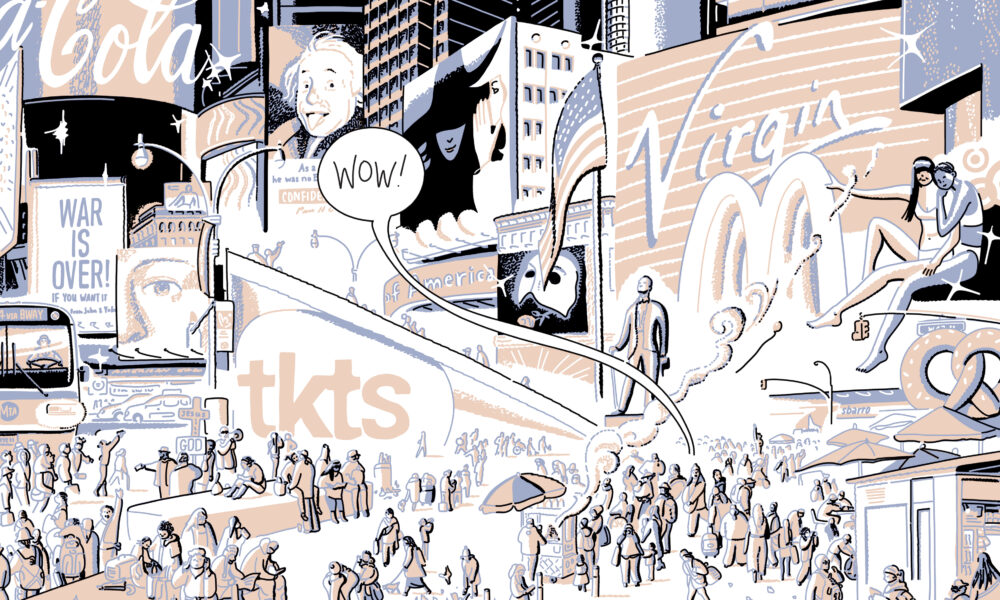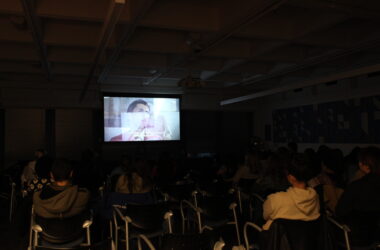NEW YORK CITY, 2009—Two Asian Canadian best friends, Dani and Zoe, have been planning this trip for ages. They seize the opportunity during their first winter break in university. Dani studies Fine Arts at Concordia; Zoe studies Life Sciences at Queen’s (she wants to study Neuroscience, but that’s just a plan, she’ll see how first year goes).
Soon enough, a problem arises. The problem’s name is Fiona, and she meets Dani at Concordia. Fiona knows New York—it’s the first place she got drunk. “With a drummer. In a Grateful Dead t-shirt.” She smokes and calls herself a bitch.
There is friendship. There is conflict. There is adventure. There is vomit.
Award-winning duo Jillian and Mariko Tamaki’s new graphic novel captures the feeling of being young and free and scared all at once with tenderness and incredible attention to detail. Even the illustration of an Ontario driver’s license is accurate—I checked it next to mine.
Reading Roaming is a peculiar paradox: At times, Zoe, Dani, and Fiona inhabit a comforting otherworld, but at others, they could jump off the page and walk down the street.
They brim with adventure, but also worry about turning on data roaming on their phones. I saw myself reflected in these characters not only as a fellow (half)-Asian-Canadian university student, but in small movements and expressions that are hard to articulate. Roaming will delight readers who have never experienced a life similar to the ones on the page. Reading it made me nostalgic for a New York I’ve never been to.
The characters inhabit a world coloured with only a black, white, lilac, and sort of peach-like hues. The reader sees the story unfold through a pastel, dreamlike, slightly hazy filter. It’s so beautiful and beguiling that—just for a moment—you forget that subway cars aren’t really pink and pepperoni isn’t really purple.
Tamaki and Tamaki’s romanticized New York is arguably a realistic portrayal: Reading Roaming feels like visiting the city for the first time. The graphics are often drawn from the perspective of someone looking up in wonder. However, not everyone is so enchanted.
As a local tells Dani, “New York City is forty per cent vampire. And ten per cent psychopath.”
The characters’ struggles are both tremendous and trifling. There are seemingly ordinary trials: Zoe is perpetually put off by the radical greasiness of New York pizza, and habitually dabs her pizza with a napkin. Dani goes shopping and can’t find any pants that fit her—an experience shared by nearly every teenage girl I know.
Between these everyday moments, or perhaps even simultaneously, they tackle issues bigger than any of us: During a conversation about the hyper-vigilance of American border security, Dani recalls her dad being pulled into an airport interrogation room. Fiona asks her if it’s because he’s not white. Dani hesitates.
“Oh. Uh. Maybe? He’s Korean. So that’s like… different?”
Later that day, an older man harasses them at a bar. Fiona tells him to leave, and he leans over the table. She tells him to go fuck himself, and he calls her a fucking bitch. The moment may seem out of place in a pastel-coloured friends’ trip to New York, but it’s also one intimately familiar to many young women traveling with friends—one moment, you’re taking in a new, beautiful city, the next, you’re catcalled into a harsh reality.
Zoe and Fiona have a complex relationship—they share a kiss in the butterfly garden at the Museum of Natural History, and more. Zoe also bristles when Fiona tells her she has “that cool d*ke thing going on.” Roaming isn’t a fantasy. Relationships aren’t only beautiful. They’re also destructive.
More often than not, developing feelings around race, identity, family, and sexuality are not articulable, much less understandable. Roaming is not a manifesto; it’s real life. The characters of Roaming struggle and fail and refuse to give us clear-cut answers, just as real friends do.
Roaming was published Sept. 12th and is available at local bookstore Drawn and Quarterly.









